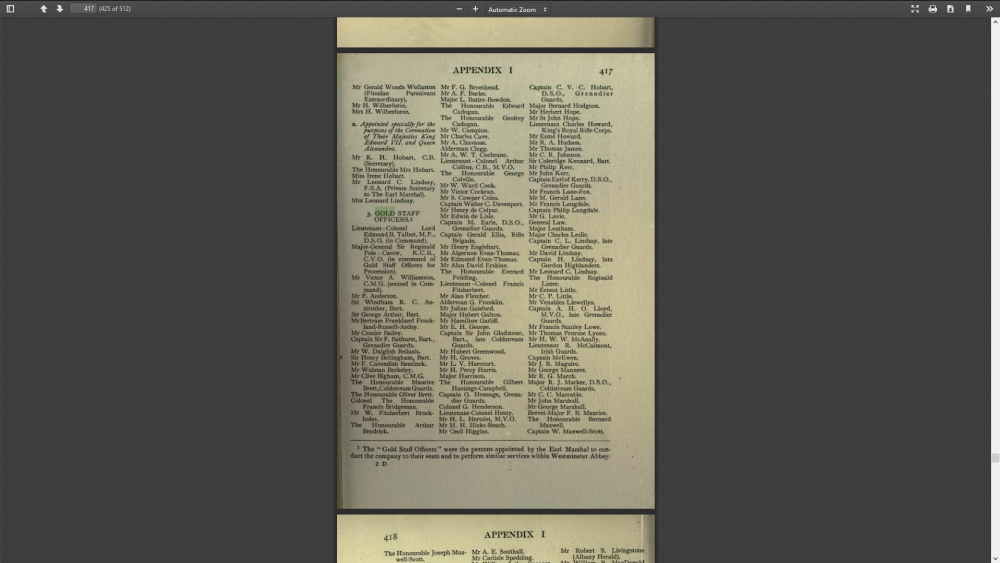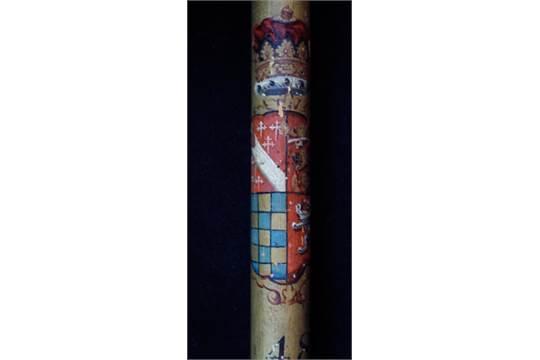-
Posts
104 -
Joined
-
Last visited
Content Type
Profiles
Forums
Blogs
Gallery
Events
Store
Posts posted by Nightbreak
-
-
May have moved to the States or to the UK and just had his medal sent on to him there.
0 -
The 18th was the Prescott Infantry. 245 medals to the unit, plus about 17 late issues.
You're looking for Thomas J. Everett in or around Prescott, Ontario.
In the 1871 Census, that's who we find. 21 year old Thomas J Everett, a Farmer in Hawksbury East, Prescott.
No sign of him in the 1881 or 1891 Census, though, oddly. Because the medal would have had to be claimed by him in 1899 or later.
http://data2.collectionscanada.ca/1871/pdf/4396763_00272.pdf
Hi, Irish. I'm Andrew, and Colonial Canadian medals are my specialty.
 0
0 -
Oh, now, Brian. I read your blogs. I just don't have much to comment on, because I'm only four years into truncheon collecting and I'm busy soaking up knowledge from you all.
Nice tipstaff, Mark. If you start collecting, choose your specialty early!
0 -
-
I wonder if it's the same one sold by Campbell Auctions in 2011. The estimate on that was £120 - 150, but I don't know what the hammer was.
0 -
Richard,
Thanks for your input on this thread. It's nice to see another baton collector. Would you have any thoughts on this piece I picked up at auction last year? Duke of Norfolk's baton, gold with black ends, with 48 beneath his crest. I was told it was Victorian, possibly for a Coronation or Investiture ceremony.
0 -
I think he meant he was 'offered the chance', but didn't take it, as he's not a truncheon collector.
That particular staff from Canterbury Auctions wasn't my main interest, as I was after the Norfolk, Longe, and Cator family staves that were at Keys Auctions the year before, and I had been the underbidder there. I know there was some bump-up in the price, but wasn't about to lose them a second time! The Carmunnock tipstaff was a nice addition to the collection on top of that.
I'm still looking for one from the Keys sale, also from the Longe Family, but it hasn't appeared yet. It might have been the Sheriff of Norfolk's staff, or a manor stave. I figure the seller wishes to hold onto it a bit longer.
0 -
His widow sold me a copy of his book on Amazon, and it was then I realized I had one or two of his pieces. My interest is purely in the 24 - 36 inch decorated staves, but I won't say no to a good short tipstaff, either! I've posted my collection in here already, but I know I'm still short a few good examples, like Dysart, Midlothian, and a proper Edinburgh long stave.
Some of the items John had, though, were absolutely lovely, like the Red Rod.
0 -
The Duke of Norfolk's staff I picked up in the same auction came to more than that and is considered Victorian, rather than Georgian. And I have an Edinburgh High Constable's tipstaff that was £500 a couple years ago at Burstow & Hewitt. Compared to those, I'd consider it a bargain, especially as they're so few in number.
At the same time, I was the only bidder on those lots, and even scored a small reduction on each. The auctioneer wasn't wasting time, passing on lots after one price drop.
0 -
-
-
Seven of them are here. About half of them have been confirmed by either museums or previous collectors as authentic, but they're sometimes difficult to pin down, due to the variety made in various parts of the country and just my inability to find the right people to identify some of them. The most Mervyn Mitton said about them was "They come in a variety of shapes and sizes." and went on from there.
The High Constables had a pattern (Perthshire, Edinburgh, etc) , but the others were often hand-made and painted. Others were suggested to be magistrates' staves, as opposed to constables.
Not pictured is my Edinburgh High Constable's tipstaff, possibly one from Mervyn's collection, and a yet-to-arrive tipstaff from John Green's collection.
Left to Right:
George III - Kinross-shire Constabulary
William IV - Aberdeen
George III - Calton, (Glasgow or Calton Hill, Edinburgh?)
1911 Investiture of the Prince of Wales "Green Staff Officer's Baton"
George III - Edinburgh Midlothian Magistrate's staff (according to Paul Wharton)
Victoria - Kirkcaldy (This one bothers me the most, as the crest is upside down, and I remember another thread on here about how truncheons are displayed for all the details to be seen upright. The constabulary of the burgh had the numbers necessary for 26 in Victoria's reign, but it's got a larger circumference than most. This was one Mervyn noted in his book that would have 'usually only a crown, the cipher 'VR' and and sometimes the identification of the relevant town.' Possibly a magistrate's instead.)George III - Brechin (matches John Green's illustration of Victorian Brechin staves)
Victoria - PerthshireI know there are still some from Edinburgh, Midlothian, and probably Leith and other burghs out there.
0 -
I'm grateful for the experts who took the time to compose their knowledge and make it available, as well as those of you who pointed me towards it. The collection of Scottish tipstaves is now at 9, and other pieces aren't formally identified yet. I'll upload some pictures soon.
Out of idle curiosity, does anyone know the best way to arrange a visit of the museum at the Scottish Police College in Tulliallan?
 I was told they have an excellent collection of their own.
0
I was told they have an excellent collection of their own.
0 -
One's always happy when it first arrives. Then the sense of pride and accomplishment gets broken by someone with more knowledge who can tell us what it really is! I dread those moments, personally.
 0
0 -
Ross, take a look at your baton, if you have it handy. Is there a metal rod through the middle of it? My Green Staff baton does, as does some of the other Gold Staff batons, and it may be an indicator of originality, as opposed to 'collector' pieces, as Mervyn dubbed them. (I think the George V in that picture of the three you posted was the only authentic one, unless the style was replicated over time)
0 -
A couple of years ago, I purchased a truncheon, one of a few lots from Lockdale's. (I regret not bidding on some of the others offered, but was new to collecting and hadn't yet made the decision to specialize). The official description was
Police Truncheon - unidentified c1805/1810 Police LongStave, colour painted with a House and 41 (63cm)Several suggestions were offered by Mervyn Mitton and others on here, and I consulted several Scottish museums in the process. Nothing seemed to fit. There's a difference between short/long staves, and I'm not sure if the line's at two or three feet long. (63 cm - 92 cm)Then, last year, I finally acquired a copy of Alan Cook's Truncheons, An Unequal Match, and hoped to solve the mystery. No luck, however, and I asked him about it, whereupon he recommended John Green's book Scottish Insignia as Used by Old Police Forces. Luckily, one was available and I figured "Well, one more book won't hurt".Bingo. The truncheon/staff in question had been part of John's collection, and it was illustrated in the colour plates in his book. It belongs to Kinross-shire, and the House mentioned in the description is meant to represent Lochleven Castle.So thanks to Alan, Meryvn, (posthumously, as your own book has been an invaluable source of learning), and everyone on here who had ideas on what this piece of wood was.0 -
You're a step ahead of a few collectors, having a name to go with the artifact. You could always attempt a search of Ancestry, although without a first name, you might need to start with the UK census of Surrey for the first few years until you can find someone employed as a policeman with the last name of Hunter.
There are links to the Parish register at Family Search
0 -
Ross: Just bought these in December. The College of Arms tells me that the top one is most likely a Green Staff Officer's baton. 1911 Investiture of the Prince of Wales (First investiture ceremony held in over 600 years). Sadly, their information on the 1911 ceremony is light at best, so they couldn't tell me who the Officers were.
0 -
Ooh, thanks, Nick. Very generous of you (and them, naturally!)
0 -
Amazing that your family went from Canada to Alaska. Must not have been cold enough for them when they arrived in the first place!
Someone's obviously enjoyed a lifetime of collecting, though, to look at some of those lots. The dealers are probably going to pick up a great deal of them.
0 -
Dave: No, I'm not acting for the auction house.
And if they want to up the bid and spend their money to beat me, they can try. This is putting out that a large collection is available for my fellow collectors, if any of them are interested. The more we know about each other's themes, the more we help each other.
0 -
Looks like someone's collection is going under the hammer at Canterbury Auction Galleries next week. There looks to be about 50 or so lots of truncheons and tipstaves, sold in lots of singles, 2, 3, and 4.
Be warned, as usual, if bidding, that the buyers' commission here is 24%, plus 3% for internet bidding. Payments that involve credit cards are another 2% with VAT, and if you win high, you may be expected to pay by bank transfer, which opens you up to a lot more fees, from both receiving and sending banks. (I've run the ropes a few times with different houses and banks.)
I've got one lot in mind, with that Scottish William IV Aberdeen staff. Perfect for the theme! I'm trusting you all not to run my bid up!
 0
0 -
Thanks, Dave. That's a couple of lovely leads.
Of course, it also always helps to have a copy of Mervyn's book at hand!
0 -
I've been wondering recently what sorts of resources are out there to help us identify some of the markings on our truncheons and other staves. Often the auction houses or sellers do the adequate research or the town names are painted on the wood, but in many cases, it's unidentified and we have to rely on some expert work or another.
http://www.ima-usa.com/original-british-victorian-painted-police-truncheon.html
Here's an example of the dealer not mentioning that the truncheon is a Cambridge University piece. I had to flip through a heraldry book online to pick out the proper nomenclature to even begin looking up what it meant.
http://www.gutenberg.org/ebooks/23186?msg=welcome_stranger
This doesn't apply to town crests, either, many of which are sometimes hard to describe properly to bring up a good result. Edingburgh, Manchester? Fairly easy. Coats of arms of smaller counties? Not always simple.
So, what other resources are out there? What do you use?
0











Fenian Raid Medal Identify
in Great Britain: Orders, Gallantry, Campaign Medals
Posted · Edited by Nightbreak
I checked for all of Canada, once I saw he hadn't appeared in 1881. No matching ages, even on either side of 31. It seems none of his family members remained in Hawkesbury, either.
1861 Census seems to have his parents as CW and Eliza Everett, 48 & 49 years old respectively, and another 8 Everetts beneath them.
In 1871, at 21, he's now listed as head of the household, with his mother Eliza at 58. They are an Irish family, too.